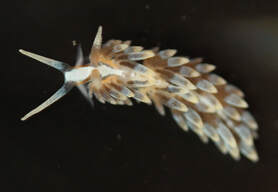The Goodheart lab strives to understand how complex features originate and diversify, with a particular focus on the sequestration of external structures and chemicals. This involves identifying and evaluating the variation of features (morphology, behavior, physiology, etc) among different taxa in the context of well-supported phylogenetic hypotheses.
We use genomic data and the most current bioinformatics tools to generate well-supported phylogenetic hypotheses, and use these hypotheses as frameworks for characterizing the origin(s) and macroevolutionary patterns of particular complex traits. Our work largely focuses on heterobranch gastropods, which do not produce an adult shell and have evolved a number of interesting, and likely associated, features including sequestration of cnidarian nematocysts and potent chemical defenses.
We use genomic data and the most current bioinformatics tools to generate well-supported phylogenetic hypotheses, and use these hypotheses as frameworks for characterizing the origin(s) and macroevolutionary patterns of particular complex traits. Our work largely focuses on heterobranch gastropods, which do not produce an adult shell and have evolved a number of interesting, and likely associated, features including sequestration of cnidarian nematocysts and potent chemical defenses.
Current Research
Nematocyst sequestration evolution
|
Phylogenomics, Systematics, and Taxonomy
Understanding the evolution of nematocyst sequestration in an integrative framework first requires solid grounding in phylogeny and natural history. Dr. Goodheart previously identified at least two origins of this ability (both within the same group of nudibranchs, called Cladobranchia), and future phylogenomics and systematics work in our lab will seek to infer more highly supported phylogenetic and taxonomic hypotheses that we might use to infer how nematocyst sequestration relates to speciation. Current projects include using targeted sequence capture to infer the relationships among Hancockia species and closely related groups. |
|
Morphological and Ecological Evolution
Dr. Goodheart previously proposed a series of ecological, morphological, and functional changes we might expect to lead to the origin of nematocyst sequestration. One goal of our lab is evaluate this model for the evolution of nematocyst acquisition using comparative morphology analyses, using the most up-to-date imaging techniques (including micro-CT), and field observations. Current work includes investigating morphological differences in cnidosacs and cerata among a nematocyst sequestering species, in collaboration with Dr. Heike Wägele at the Museum Koenig Bonn in Germany. |
|
Molecular Mechanism of Sequestration
Research in our lab also makes use of the emerging model nudibranch Berghia stephanieae to investigate nematocyst sequestration at the cell and molecular level. We hypothesize that conserved mechanisms of phagocytosis were modified in nudibranchs to allow them to target nematocysts for sequestration. Current work in our lab involves investigating gene expression differences that correlate with the development and process of nematocyst sequestration to identify genes important for this process. |
Other Research Topics
|
Evolution of Autotomy and Regeneration
Nudibranchs can actively autotomize (aka release) parts of their body. Autotomy is a physiological response in which an organism voluntarily detaches a body structure at a predetermined breakage point in response to external stimuli. In heterobranchs, the autotomized appendages often contain the most potent deterrent substance against predation. In the Goodheart lab, we are interested in investigating how this defense mechanism works using the species Berghia stephanieae as a model. We are also interested in reconstructing how autotomy has evolved within nudibranchs using phylogenomic and ancestral trait estimation. |
|
Evolution of Bioluminescence
The family Cypridinidae contains a number of tiny crustaceans called ostracods. Some of these species possess the ability to create magnificent courstship displays using trains of luminescent pulses. In a previous lab, Dr. Goodheart helped cultured the luminous ostracod Vargula tsujii in the lab and described the development of this species. We are interested in how these animals evolved bioluminescence producing organs (upper lip) and how these organs changed at the origin of luminous courtship. Current projects include cypridinid phylogenetics, upper lip morphological evolution, and taxonomy (collaboration with Dr. Todd Oakley at UC Santa Barbara) |





